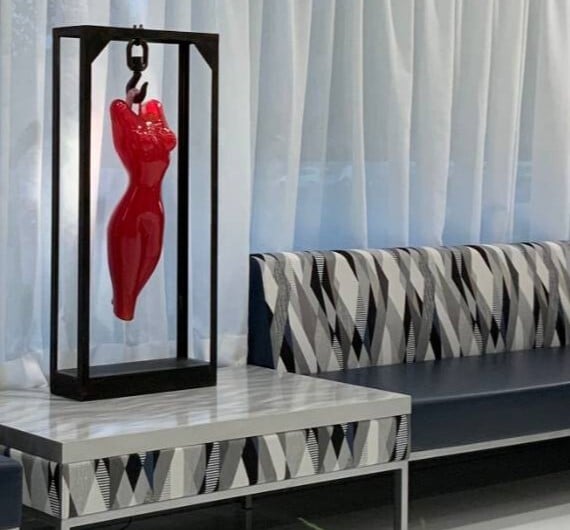What is Synmastia?
Synmastia refers to a condition where the breasts are too close together. Synmastia is usually not something that happens due to unpredictable tissue stretching. It is usually a result of improper dissection of the surgical pocket for the implant. There are always exceptions to this, but this is usually the case.
First, lets discuss what synmastia is. Synmastia is a medial (inner) malposition of the breast implants. This will cause the breasts to lie too close together, to the point that that implants themselves are so close that the skin overlying the sternum (breastbone) lifts off the bone itself. Some people have nicknamed this condition a “uni-breast.” This is different from “cleavage.” Most women who undergo breast augmentation want cleavage. Cleavage is when the sides of the breasts are very close together, if not touching completely, but the skin over the sternum is still tightly affixed to the bone. This preserves the gentle curvature of the inner breast all the way down to where it meets the chest wall.
Breasts normally do not touch in their medial (inner) portion. The base of the breast is defined as the portion of the chest wall between the outer and inner borders of the breast. The inner borders can be close together, or further apart. I see variations of this all day long in my breast augmentation patients. When an unaugmented woman has cleavage, it is because the breasts are large enough and close enough to be squished together in a bra. The larger the breasts naturally are, the easier this happens. For smaller breasts, the breasts need to be relatively close together to achieve cleavage in a bra. Except for woman with very large breasts that naturally have a very narrow gap between the inner aspect of each breast, cleavage never happens naturally when the breasts are upright, and unsupported by a bra or other type of garment.
Although I have not seen this described, I would like to break this up in to two categories: True synmastia and False synmastia. “True” synmastia occurs when the breasts are always too close together and the skin between the breasts over the sternum (breastbone) is actually lifted off the bone, and “false” synmastia is when the breasts at rest are at normal distance but certain clothing pushes the breasts a little closer together than the patient desires.
How does True Synmastia occur?
In order to understand how true synmastia occurs, you need to understand how the breast pockets are developed and what keeps the breast implants in place. Breast implants can be placed either above the muscle (subglandular) or below the muscle (submuscular). True synmastia can occur with either subglandular or submuscular placement of implants because of one or both of two basic errors occurs:
- The implant pocket is created too far inward towards the breastbone
- The implant selected is too large for the chest and the resulting pocket requires the inner aspect of the breasts to be too close together
For more information submuscular versus subglandular placement of implants, click here.
Subglandular Placement of Implants
When the implant is placed above the muscle (I cannot think of a single indication to do this in a first-time augmentation), the breast tissue is elevated off the underlying pectoralis major muscle. There is very little breast tissue on the medial (inner) aspect of the breast. The inner aspect of the pocket will consist of only skin that was elevated off the ribs towards the breastbone. There is only the attachment of this skin on the breastbone to act as a barrier to prevent the breasts from being too close together.
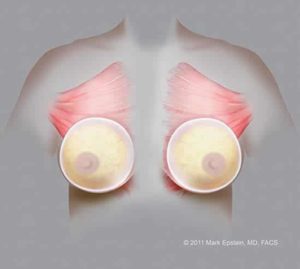
If the surgeon dissects the pockets too close, or if the skin stretches excessively (this is more likely when using over-sized implants) then the implants will be too close. The implant size itself may be otherwise appropriate for the chest size of the patient. This is one of my many criticisms of subglandular placement of breast implants.
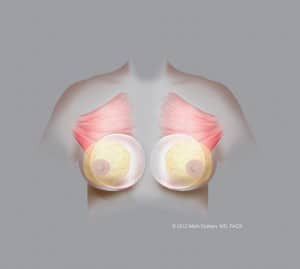
Synmastia can occur also because of use of implants that are too large for the chest, the inner implant borders to be too close together, as well as protruding too far to the sides, as well as too high and too low on the chest. Sometimes, the combination of errors, both over-dissection too far medially and selecting an implant too large for the chest dimensions (which necessitates over-dissection medially) contributes to the development of synmastia.
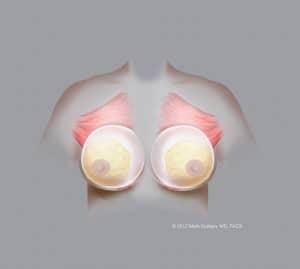
Submuscular Placement of Implants
Submuscular placement refers to placing the implant underneath the pectoralis major muscle. The situation is very different here. A muscle has two attachments to the body; an “origin” and an insertion”. The origin of the pectoralis muscle is the chest along the side border of the breastbone, and also for about 2 – 3 inches along the ribs near the bottom of the breastbone. The insertion of the muscle is on the upper portion of the humerus (the upper arm bone). The intervening area of the muscle is attached to the chest with only filmy tissue to allow for muscular gliding during contraction and relaxation. This tissue is easily separated to make room for the implant underneath.
As long as the surgeon leaves the muscle’s attachment to the sternum intact, the muscle will act like a bouncer in a bar…it keeps the implant from extending towards the breastbone because the muscle is physically standing in the way of the implant from doing this. This is one of the many advantages of submuscular placement.
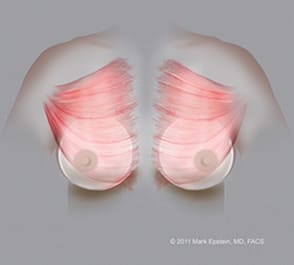
If the surgeon cuts through and releases the muscular attachment to the breastbone, then there is only thin skin overlying the inner aspect of the breast (which can result in noticeable “window-shading” or horizontal lines across the inner breast) as well as the possibility that this skin can be elevated off the chest, just like in the subglandular case, and result in synmastia. If synmastia occurs with subglandular placement, the implant can be relocated to the submuscular position (called a “site change”) which is fairly simple. If the original augmentation was a submuscular placement, the repair is a little more intricate.
How does false Synmastia occur?
“False” synmastia refers to a condition where the breasts appear to be in the correct position when upright and unclothed, however, wearing a bra, bikini top or other clothing intended to bring the breasts closer together may result in exaggerated malposition of the breasts closer together, thus causing the appearance of synmastia. This typically occurs when the lower edge of the pectoralis muscle is released too far upwards, eliminating the muscle barrier preventing the implants from being displaced inwards. Certain clothing can then push the implants too close together. Lateral pocket underdissection, and/or an excessively large implant can increase the forces on the implants pushing them together, worsening the problem. Inferior implant malposition can also exacerbate the problem by creating a situation where the implants are now lower than the attachment of the pectoralis muscle on the breast bone, and therefore they cannot keep the implants apart.
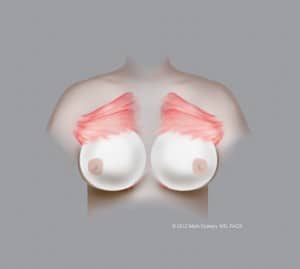
pectoralis on the breastbone
Sections – Implant malposition/bottoming out of the breast
- Incorrect Development of the Pocket
- Correction of Incorrect Development of the Pocket
- Lower Pole Stretch / Inferior Implant Malposition
- Correction of Lower Pole Stretch / Inferior Implant Malposition
- Lateral Displacement / Lateral Implant Malposition
- Correction of Lateral Displacement / Lateral Implant Malposition
- Synmastia / Medial Malposition
- Correction of Synmastia / Medial Malposition
Prev Section: Explantation (Removal of implants) »
Next Section: Change of Implant Size »
Sections – Revision of Breast Augmentation
- Capsule contracture
- Explantation (Removal of implants)
- Implant malposition/bottoming out of the breast
- Bio-materials Used in Revision of Breast Augmentation – Strattice, GalaFLEX and GalaFORM
- Implant size change
- Change from textured to smooth implants
- Changing from saline to silicone gel filled implants
- Adding a breast lift later
Prev Chapter: Important Things to Consider When You Decide to Move Forward With Breast Augmentation »
Next Chapter: ALCL and Breast Implant Illness »
Chapters – Breast Augmentation Guide
- Intro to Breast Augmentation
- Motiva Breast Implants
- Five key decisions you need to make
- One-Day Recovery Breast Augmentation
- Anesthesia – General, Sedation or Local?
- Breast Lift (Mastopexy) with/without Implants or Fat
- What else should I know about breast augmentation?
- Important Things to Consider When You Decide to Move Forward With Breast Augmentation
- Revision of breast augmentation
- ALCL and Breast Implant Illness
Schedule A Consultation
Contact our Long Island office at 631.689.1100 for more information regarding repair of implant malposition.


